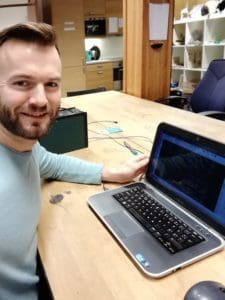I went to Berlin with Elias Bakken. It’s such a cool city.
We met up with Helen Leigh and Drew Fustini to eat kebabs, see homemade instruments, play artsy video games and learn about sewable circuits.
Check out the video below!
I started this blog in 2012 with the idea of being able to do what I love (electronics) while traveling.
Since then, I’ve traveled and lived all over the world. I’ve been to Mexico, Colombia, USA, Australia, China, Fiji, Germany, Singapore ++.
In this section, you can find articles related to my travels and the lifestyle of being a maker.
In this episode, we talk about operational amplifiers (opamps) and the 4000 series IC that Øyvind has been writing a series of posts on. We also accidentally came across a funny error on Arrow’s website 😅.
5 years ago today, I launched Ohmify from my laptop while traveling in Colombia. I had spent the previous night in a tree hut on the beach to recharge my batteries. Now the moment had come… I was finally launching Ohmify! Something that I’d dreamed about for a long time. I created Ohmify to be
In this episode, we repair an old Sanyo amplifier. In this episode, we find an old amplifier in the trash and we try to repair it. Will we able to? Listen and find out. Listen to the Podcast Show Notes
In this episode, we start out with the idea of building a buck converter with a microcontroller. We realize that we’ve never built a buck converter before, so we go through our thought process live to figure out what we need to do. We built one buck converter each. Elias used a Bluepill and Oyvind
We talk about a custom NAS build that hooks up a screen and buttons to an Odroid, Øyvind has been developing for nRF52-something and finally we discuss some basic electronic stuff that we ought to know.
We talk about the new Arduino Polenta and how DisplayPort over USB C might be implemented. We also talk about the $42 Etepon scope vs the $3500 Siglent SDS5034x scope.
This time we discuss debugging circuits, both simple and advanced. And we talk about 3D printer electronics.
Elias and Oyvind met up in Spain to record their first-ever podcast. Are USB circuits hard? And what makes an oscilloscope expensive?
I went to Berlin with Elias Bakken. It’s such a cool city.
We met up with Helen Leigh and Drew Fustini to eat kebabs, see homemade instruments, play artsy video games and learn about sewable circuits.
Check out the video below!
“We’re never going to make it!”
Jensa and I arrived early at the airport in Oslo.
But that didn’t help. Because our flight from Oslo had technical problems. So it was delayed and we missed our connecting flight to Hong Kong…
Not a good start of our trip…
 Texas Instruments sponsored me to do a challenge and write this post.
Texas Instruments sponsored me to do a challenge and write this post.
What would it be like to not have access to power plugs?
That’s what Texas Instruments challenged me to try.
They’ve built some really nice resources that you can use in your next power supply design, and now they want to spread the word: www.ti.com/power
In the challenge, I could not use any device that was plugged in for a whole day.
So, to prepare for the day, I charged up my two most important devices: My mobile phone and my laptop.
At 6.30 my alarm clock wakes me up. (It’s an app on my phone, so it’s allowed ;) )
 Do you have a non-profit project that you’d like to build? For example for a competition or a school project?
Do you have a non-profit project that you’d like to build? For example for a competition or a school project?
Now you can get free printed circuit boards for your project.
A printed circuit board, or a PCB, is a board specifically designed for your project. And it makes it much easier to create projects that need a lot of connections.
To make a PCB you first need to create the schematics for your circuit. Then draw the connections you need in a PCB design software such as Eagle, KiCAD or Fritzing.
This drawing is then sent to a PCB manufacturer that will produce the final board for you. Then all you have to do is to solder the parts onto your board.
Many people ask me how to get a job in electronics.
Here’s my advice:
If you want a job in electronics, show them that you love electronics.
I’ve previously gotten a job as a Python programming teacher without knowing Python. And I’m convinced it was because I showed them that I loved programming (which I do).
 What do you buy for Christmas for someone who’s interested in electronics? Check out these Christmas gift ideas and get the shopping over with.
What do you buy for Christmas for someone who’s interested in electronics? Check out these Christmas gift ideas and get the shopping over with.
Last year I received three boxes with a lot of resistors and capacitors from my family. And I absolutely loved it!
I guess a box of resistors and capacitors isn’t everyone’s cup of tea…
Instead, here are some Christmas gift ideas from me that I think every electronics-interested kid, adult or grandparent would love.

SexyCyborg is an electronics geek out of the ordinary. And I love to see people being different than the norm, especially in the hobby electronics world.
So, I knew I had to interview her.